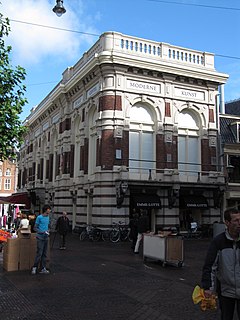 W
WThe Frans Hals Museum is a museum located in Haarlem, the Netherlands.
 W
WHenricus Petrus Baard, was director of the Frans Hals Museum from 1946-1972.
 W
WPieter Biesboer, is a Dutch art historian and prolific writer on 17th-century Dutch art. His specialty is art from Haarlem.
 W
WThe City Hall in Haarlem is the seat of the city's government. It was built in the 14th century replacing the Count's castle.
 W
WAernout or Aart Jansz Druyvesteyn was a Dutch Golden Age lawyer, painter, and mayor of Haarlem.
 W
WJacob Druyvesteyn was a Dutch lawyer and mayor of Haarlem.
 W
WCatharina Jacoba Abrahamina Enschedé was a 19th-century Dutch painter.
 W
WFrans Hals Museum - Hal is one of the two locations of the Frans Hals Museum, located on the Grote Markt, Haarlem, Netherlands, where modern and contemporary art is on display in alternating presentations. The emphasis is on contemporary photograph and video presentations, with the focus on Man and society.
 W
WGerrit David Gratama, was a Dutch artist, writer, and director of the Frans Hals Museum.
 W
WThe Haarlem schutterij refers to a collective name for the voluntary civic guard of Haarlem, from medieval times up to the Batavian Revolution in 1794, when the guilds of Haarlem were disbanded.
 W
WThe Jolly Toper is a 1629 oil painting by Judith Leyster in the collection of the Rijksmuseum that is on long term loan to the Frans Hals Museum since 1959. It was acquired by the museum as a painting by Frans Hals and was attributed to Leyster by the researcher Juliane Harms in 1927.
 W
WNicolaes van Loo, was a Dutch Golden Age brewer from Haarlem, best known today for his portrait by Frans Hals.
 W
WPride and joy: children's portraits in the Netherlands, 1500–1700, was an exhibition held jointly by the Frans Hals Museum in Haarlem and the Royal Museum of Fine Arts, Antwerp, over several months in 2000–2001. It was the first exhibition with a particular focus on images of childhood from the early-modern Low Countries.
 W
WThe Verweyhal is an exhibition space next to the Vleeshal on the Grote Markt, Haarlem. The Verweyhal was built in the 19th century as a gentlemen's society of the former drama society, later a cultural social club, Trou moet Blycken.
 W
WThe Vleeshal is a historical building dating from 1603 on the Grote Markt in Haarlem, the Netherlands.